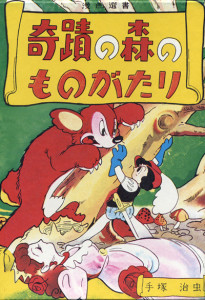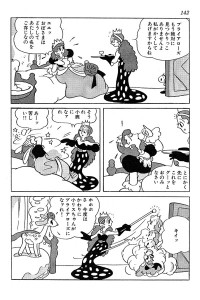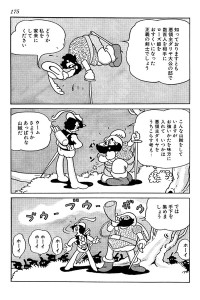Miracle Forest, The Story of a (Manga)
Also known as 奇蹟の森のものがたり (Kiseki no Mori no Monogatari)
| English Title: | The Story of a Miracle Forest |
| In English? | No |
| Japanese Title: | 奇蹟の森のものがたり Kiseki no Mori no Monogatari |
| Type: | Book |
| Original run: | 1949/06 |
| Published by: | Tokodo |
| Volumes: | <1 MT-323 |
One of Osamu Tezuka’s earliest works, The Story of a Miracle Forest (1949) was published as a book-length stand-alone adventure by Tokodo in June 1949.
What it’s about
Once upon a time, there was a magical forest, full of miracles, where all the animals lived together in peace and harmony. However, when the Grand Duke of Dahlia sends his men to go cut down the trees, the Goddess of Miracles vows to stop him.
Elsewhere, while attending a ball, Princess Briarose refuses the Grand Duke’s advances and her older brother Robin Kid is forced to hold off the Duke’s troops while she escapes – with her honour intact – deep into the forest. And so, presented with a golden opportunity, the Goddess transforms the princess into a fawn and a cute little squirrel into a stand-in for the princess, just moments before the Duke’s men arrive to bring her back.
With Princess Briarose back in his clutches, the Grand Duke of Dahlia banishes Robin Kid who, of course soon ends up in Miracle Forest and crosses paths with a strangely friendly and familiar-looking fawn…
Meanwhile, the Duke, still smitten with the lovely young Princess (i.e. Squirrel) agrees to stop clearing the forest one on condition… If the Princess will agree to marry him. However, a squirrel is still a squirrel, even if she looks like a princess, and the castle is soon abuzz with Princess Briarose’s odd behaviour, including a sudden fear of dogs, and a newfound skill at climbing.
Soon Robin Kid learns the truth about his sister, and sets off to find a cure. Along the way, he crosses paths, and swords, with the leader of a group of bandits, but wins him over and together they set off for Milk Island to try and convince the sorceress to save the fawn. After a sea journey that includes an attack by turtles, the trio are saved by a mermaid, who unbeknownst to them, turns out to be the Goddess in disguise.
Although the Goddess convinces her mother, the Sorceress of Milk Island , to trap our heroes in a spell, Robin Kid turns the tables on his would-be attackers. And so, the sorceress is turned into an insect while the real Princess Briarose is restored to human form instead. With mission accomplished, they set off to save the squirrel from a marriage worse than death.
Meanwhile, the squirrel, who is growing weaker by the day because she is unaccustomed to living as a human is approached by the Duke’s brother with a plan to poison the Grand Duke of Dahlia. However, the heroes, posing as doctors come to treat the ailing princess, are able to administer some of the remaining magic potion to the Duke, which transforms him into a squirrel himself. In the ensuing confusion, the Duke’s brother and the squirrel Princess escape.
In the end, even though the Miracle Forest is now safe from the Grand Duke’s plots, tragically, the squirrel drinks the poison and dies.
What you should know
Although Tezuka’s Princess Knight [Shojo Club] (1953-56) is often, and erroneously, credited with being the first manga specifically aimed at little girls (shojo), both The Four Fencers of the Forest (1948) and, its thematic companion piece, The Story of a Miracle Forest (1949) precede it. So, despite the fact that Princess Knight [Shojo Club] (1953-56) gets all the glory, it certainly owes a debt of gratitude to its predecessors.
Of course, as one of Tezuka’s earliest works, this western-style fairy tale follows his signature, “all-in-the-can-and-shake” style of storytelling. It features a fast-moving, somewhat frenetic plot that skims over a great many details, and relatively one-dimensional characters. However, many of the story elements – including the transformed Princess, the magical sorceress, the mysterious island, the evil Duke, and even the European-style outfits – that would be more fully-explored by Tezuka in later works, are here in embryonic form.
The Story of a Miracle Forest (1949) is also notable as it is the first instance of Osamu Tezuka breaking into the “fourth wall” and inserting himself into the story. However, this too, is still early in the game, and it is not a random and unexpected appearance to break the tension, as he does in far too many manga to list. Nor is it a case of Tezuka playing an integrated part of the storyline, like he does in Son-Goku the Monkey (1952-59) or, possibly most-famously, in Vampires (1966-69). Instead, he simply makes an appearance as the humble narrator, but it’s a sign of greater things to come.






